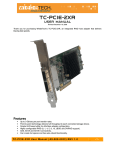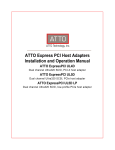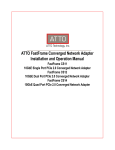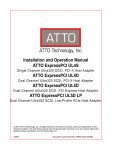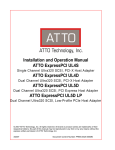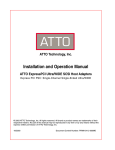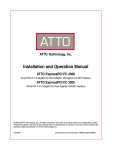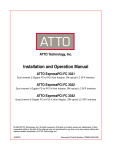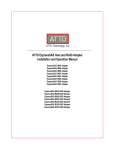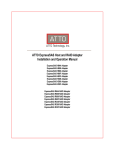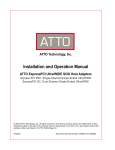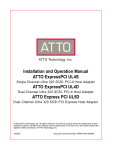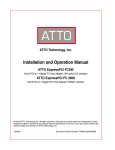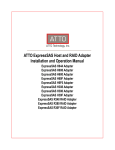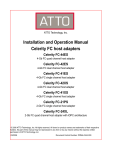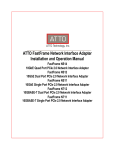Download Atto EPCI-ESTR-000 storage software
Transcript
ATTO ExpressStripe Installation and Operation Manual RAID for Mac OS X ATTO Technology, Inc. 155 CrossPoint Parkway Amherst, New York 14068 USA www.attotech.com Tel Fax (716) 691-1999 (716) 691-9353 Sales support: [email protected] Technical support: Monday -- Friday, 8am-8pm EST [email protected] © 2008 ATTO Technology, Inc. All rights reserved. All brand or product names are trademarks of their respective holders. No part of this manual may be reproduced in any form or by any means without the express written permission of ATTO Technology, Inc. 4/2008 ...................................................................................................................................................PRMA-0303-000MD Contents 1 ATTO ExpressStripe Provides Storage Solutions ............................ 1 ExpressStripe highlights System Requirements 2 RAID Overview ................................................................................ 2 RAID Level 0 ATTO recommendations 3 Using ATTO ExpressStripe .............................................................. 3 Install ExpressStripe Web software authorization Quick start guide Error messages 4 Initializing Drives .............................................................................. 5 Possible error messages 5 Creating a Standard Volume ............................................................ 7 Example of data storage technology Create a single Standard Volume Create several Standard Volumes Specify properties Successful completion Possible error messages 6 Creating a RAID 0 Volume ............................................................... 11 Create a single RAID Volume Create several RAID volumes Specify properties Successful completion Possible error messages 7 Deleting a Volume ............................................................................ 15 Possible error messages 8 System Information Utilities ............................................................. 17 Benchmarking a Volume Test parameters System information Appendix A Glossary ........................................................................... i Appendix B Host Adapter Selection Guide .......................................... iii 1 ATTO ExpressStripe Provides Storage Solutions Congratulations on your choice of the premier volume creation and management application for the Macintosh® OS X operating system. • • • Includes the ATTO Benchmark utility Wizard-style interface for easy setup Optimized for ATTO ExpressPCI and Celerity host adapters Striping interleave sizes of 4KB to 4MB allow application tuning Support for sector sizes greater than 512 Bytes Retrieves drive information Provides a visual representation of volumes, partition maps and system logs Provides integrated support to mount ATTO ExpressRAID for Mac OS 9 RAID Volumes, providing seamless support for legacy storage without costly, time-consuming data conversion Using the OS 9 Compatibility Extension available for download from the ATTO web site at www.attotech.com/software/drivers.html, mounts, reads from and writes to volumes created in ExpressStripe OS X Supports hot swap of drives attached to ATTO Celerity, ATTO ExpressPCI FC, ATTO ExpressPCI SCSI Ultra3 and ATTO ExpressPCI SCSI Ultra 320 adapters With its easy-to-use interface, ATTO ExpressStripe for Macintosh OS X gives you the power to optimize your storage without a complicated user interface. Whether using your Mac for high-end digital video editing, database management or other high performance applications, ExpressStripe for Mac OS X gives you the power you need to work more efficiently with volume creation and management. Using a wizard-based interface, ExpressStripe for Mac OS X makes volume creation simple. By following a series of straight-forward steps, you can set up and begin to use your storage faster than ever. ExpressStripe for Mac OS X provides RAID Level 0 functionality. Using this application, you can make several storage devices work together, making a larger virtual disk and taking advantage of the combined performance of those devices to match the needs of high-bandwidth applications. This software package also includes the ATTO Benchmark tool. This user-friendly utility reports and graphs the peak, average and minimum read transfer rates. If you need additional assistance, comprehensive online help text is available along the way. Click on the help button for additional information on the specific operation. System Requirements ExpressStripe highlights • • • • • • • Creates Standard and RAID 0 volumes Support for volume sizes up to 8 exabytes support for multiple Macintosh OS X file system formats Creates multiple volumes simultaneously Supports SCSI, Fibre Channel, FireWire and ATA storage protocols 1 ATTO Technology Inc.: RAID for Macintosh OS X • • • • • • • • Mac OS X Attached storage and cables. For SCSI, SAS and Fibre Channel storage, we recommend an ATTO ExpressPCI SCSI, ExpressSAS SAS/SATA, ExpressPCI FC or Celerity FC Host adapter. Minimum one hard drive for volume creation; two hard drives for RAID compatibility in addition to the root drive. 2 RAID Overview Originally Redundant Array of Inexpensive Disks, now Redundant Array of Independent Drives, RAID is a storage system using multiple disk drives. ATTO ExpressStripe creates virtual disk arrays on physical drives to increase capacity and performance. Large amounts of data can be supported over many smaller drives when the drives are combined into one large “virtual” drive. Management is easier than using several drives in a JBOD (Just a Bunch of Disks) configuration. RAID overlaps disk seeks, minimizing aggregate seek time delays for the storage group as a whole. Data is written in equal, short operations to each member of the RAID group in turn so that when the first member of a group begins writing to disk, the second member is available to take data. This continues until the last member of a group is writing to disk, and the first member of a group is ready for data. RAID also takes advantage of the Macintosh OS ability to create partitions and volumes. RAID Level 0 RAID Level 0 is commonly used when performance is more important than data-protection. RAID Level 0, or striping, achieves higher I/O performance by breaking data into smaller units, then writing the data to separate physical drives. These striped volumes can then be read from the separate, physical drives, and re-assembled into the actual data with minimal delay. You must have at least two physical drives to create a striped volume ATTO recommendations • • • • Although RAID 0 volumes can be created using different types and models of drives, use similar types/models to ensure the access time is equal to the average access time of a single drive rather than the access time for the slowest drive. For maximum performance, use a dual channel host adapter with drives equally distributed across busses. Use RAID 0 in environments that demand high I/O rates such as video production and editing, image editing and pre-press. Since RAID 0 does not provide fault tolerance, establish a backup policy to protect data stored on RAID 0 volumes. 2 ATTO ExpressStripe Installation and Operation Manual 3 Using ATTO ExpressStripe Installing and getting around in ExpressStripe for Macintosh OS X is performed through a series of screens which lead you in the process of creating and managing storage groups. Install ExpressStripe 1 2 Begin with either 1a or 1b, depending on how you received your ExpressStripe software: a. If you purchased ExpressStripe online and downloaded the files from the ATTO website, double-click the compressed file *.tgz and extract the contents to your desktop. The application installer *.app displays. Proceed to step 2. b. If you are installing ExpressStripe from a CD, locate the application autoinstaller (*.app) on the CD. Double-click the auto-installer *.app. 3 4 5 Follow the on-screen prompts. When prompted, reboot your computer to complete the installation. Register your software online by following Web software authorization instructions on this page. Note The RAID driver is activated upon reboot. Web software authorization To start ExpressStripe for Mac OSX the first time, or when upgrading from earlier versions, you need the authorization code that was sent to you via Email. Please contact ATTO Technology Tech Support if you have not received this code. The authorization code is generated from the ATTO Technology website. 1 On the Internet, go to software registration www.attotech.com/license. html 2 Select ExpressStripe and the current version number. 3 Type in your Email address, company name, and serial number (found on the ExpressStripe CD case). 3 ATTO Technology Inc.: RAID for Macintosh OS X Note Your authorization code is sent to you via Email message. 4 Enter the authorization code when prompted to do so. Quick start guide If you are already familiar with partitions, volumes and RAID 0 configurations, ExpressStripe gives you easy access to information and configuration parameters. Note Close all other applications before using ExpressStripe. • • • • • Settings in the application are not persistent. If you make changes on one screen and then make changes on a previous screen (using the back button), the original screen is reset to the default settings. Click on the Create button to create a new Standard or RAID 0 volume. Click on the Delete button to delete a currently mounted Standard or RAID 0 volume. Click on the Utilities button, then the Benchmark or Sys Info buttons for detailed information about your storage. Click on the Quit button at the bottom of the screen to exit the application. Error messages The following generic error messages may be displayed during any operation. Error messages for specific operations may be found in those chapters. Error: Could not unmount volumes. Your system has not been changed. The system did not unmount the volumes in time. You can drag the drives to the trash, and then try again. If the system can’t unmount the drives because another program has them locked, an error message displays when you try to drag to the trash. FileNotFoundException: /dev/[diskname] (device busy). IOException: /dev/[diskname] (device busy) IOException: /dev/[diskname] (not supported) IOException: /dev/[diskname] (I/O Error) process, such as when a volume is still mounted, and ExpressStripe displays a FileNotFoundException message. IOException messages are usually read or write failures. If the device is unmounted (the device is not listed when the user types df in the terminal), then another program may have a lock on the disk. Quit the other programs, and/or reboot. Depending upon which operation failed, and in what part of the process, the disks may or may not have been changed. NullPointerException This may be caused by low memory. Every operation needs to open the disk, and read from it or write to it. Sometimes the system prevents this 4 ATTO ExpressStripe Installation and Operation Manual 4 Initializing Drives Initializing a drive prepares a new drive for volume creation and erases all data on a disk. To prepare a new drive or completely erase an old drive, you first initialize them using ATTO ExpressStripe. CAUTION If you initialize a drive, all data on the initialized drive is permanently erased. Make a backup of any data on a drive before preparing it for volume creation. 1 2 3 On the opening screen, click on the Delete button. Click on the Initialize button. Using the mouse, highlight the drive to initialize. If you wish to initialize more than one drive, use the shift key to select consecutive drives or the open-Apple key to select specific, nonadjacent drives. 5 Verify the parameters in the task list. If the parameters are incorrect, click on the Back button and return to the Initialize Drive selection screen without making any changes to your system. 6 If the parameters on the check list are acceptable, click the Drive(s) Verified button. 7 Click the OK button. 8 ATTO ExpressStripe for Mac OS X initializes the drive(s). 9 Click Continue. Physical drive 4 in Exhibit 4.0-1 on the following page is a representation of what a drive looks like after being initialized. Possible error messages [diskname] was not initialized. Each disk is tagged with this message before initialization. If this message appears, try the initialization process over again. Initialized [diskname]. A success message: everything worked as expected. FileNotFoundException. Indicates either the empty partition map was not written out or the new partition map failed to reload. [IOExceptions] IO exceptions can occur during Erase, Initialize Partition Map and Saving Partition Map operations. [Initialization of [diskname] failed] The error is written to the console log. 4 Click the Next button. 5 ATTO Technology Inc.: RAID for Macintosh OS X Exhibit 4.0-1 Physical drive 4 is an initialized, empty drive ready for volume creation. LP denotes a logical partition of the physical drive. 6 ATTO ExpressStripe Installation and Operation Manual 5 Creating a Standard Volume ExpressStripe for MacOS X allows you to create Standard Volumes to store data on a single partition on a single physical drive. A Standard Volume stores data on a single partition on a single physical drive. The Express Stripe application creates one or more partitions with one or more Standard Volumes on a physical drive at the same time. The partition(s) can use the entire drive or may leave free space for use later. Standard Volumes are convenient to create and use but are limited by the speed and size of the drive on which they are located. The ExpressStripe application can create one or more partitions with Standard Volumes on a physical drive. The partition(s) and volume(s) are created at the same time. The partition(s) can use the entire drive or they can leave free space that can be used later. Note Click on the Back button at any time to go back one screen without making any changes on the current screen. Note Standard Volumes do not offer any data recovery mechanism to restore lost data. Example of data storage technology Each cylinder represents a separate physical drive. • Each physical drive has been divided into partitions, labelled logical partition (LP) • Physical Drive 4 has been initialized and is empty with no partitions or data. It may be used to create a Standard or striped volume. • LP7 and LP11 are free partitions that can be used to create Standard or striped volumes. • Data has been striped (RAID Level 0) across physical drives 1, 2 and 3, using partitions LP1, LP 2 and LP3, named Volume 1. LP4, LP5 and LP6 are stripe data across three separate physical drives into Volume 2. 7 ATTO Technology Inc.: RAID for Macintosh OS X • • LP8 is a Standard Volume using one partition. LP9, LP 10, LP12, LP 13 and LP14 are Standard Volumes. Note If you create a striped volume across multiple physical drives and the partitions are not the same size, only the portion of each partition equal to the size of the smallest partition is used, leaving unused space on the larger partitions of the volume. Create a single Standard Volume 1 From the Create screen, click on the Standard button. 2 Using the mouse, highlight the drive where you want the volume created. 3 Click the Next button to continue the setup process and set volume parameters, such as size and number of volumes to be created, or click the Finish button to skip the setup process and create a new Standard Volume using common default parameters. The volume uses all the free space on the selected drive. Note The number of volumes that can be created depends on the disk size and the free space remaining in the disk’s partition map. Create several Standard Volumes ATTO ExpressStripe for MacOS X can simultaneously set up several Standard Volumes on a drive. 1 Verify that the Drive name matches the drive on which to create the new volume(s). 2 Use the Free space slider bar to choose the portion of the available free space that the new volume(s) occupies. 8 ATTO ExpressStripe Installation and Operation Manual Note You may use the keyboard to enter the portion of free space, i.e. xx MB, xx GB. 3 4 Using the Number of volumes pull-down list, select the number of Standard Volumes you wish to create from the selected free space. Click on the Next button to configure the volumes. Specify properties For each Standard Volume created, you may specify properties such as format type, name and size. 1 Use the Select Volume list box to view the requested properties for a specific volume being created. The properties for that volume can then be modified. 2 Use the Format list box to select the format for the volume. 3 In the Name text field, enter a name for the volume. 4 Use the Size slider bar to adjust the size of the volume, if necessary. 8 on the Back button to return to the Create Standard Volumes number of volumes selection screen without making any changes to your system. Click on the OK button to accept your settings and create a Standard Volume. Note The graphical representation of the drive at the left of the screen helps you determine how much volume space has been allocated and how much free space remains. 5 6 7 Repeat this process for additional volumes. Click on the Finish button. Verify parameters before ATTO ExpressStripe for Mac OS X tries to create any volumes. Click Successful completion When the process you have chosen is finished, a screen informs you which operations were completed or if requested operations were not completed. Your desktop now shows the volumes you have created. You may click Quit to end the program and use your new Standard Volume or click Continue to create more volumes. 9 ATTO Technology Inc.: RAID for Macintosh OS X An ExpresStripe Volume is represented on the desktop as an ATTO drive array and clipboard labelled either Fibre Channel, SAS or SCSI, denoting the type of attached drives. Possible error messages [VolumeName]: Partition was not created. [VolumeName] – could not format. Each partition is tagged with this message before it has been manipulated. Reboot and try creating a volume again. The program can’t lay down the format on this volume. Other volumes may be formatted. [Partition map is full. This is the success message; everything worked as expected. You can create no more than 30 partitions per disk. The system has not been changed. [VolumeName] was not formatted. Each volume is tagged with this message after the partition map has been saved. The volume cannot be mounted but takes up space. You may mount the volume if you use newfs to lay down the proper format on the corresponding volume device. [VolumeName] created. [VolumeName]: BSD name does not exist. If IOKit does not make the volume devices after the new partition map has been saved, there is nothing to format. Reboot and either newfs the proper volume device or initialize the entire drive. FileNotFoundException or IOException. Indicates that the partition map could not be saved which could occur after a partition map has been saved. No changes are made. 10 ATTO ExpressStripe Installation and Operation Manual 6 Creating a RAID 0 Volume ExpressStripe for MacOS X allows you to create RAID Level 0 volumes. RAID Level 0, or striping, achieves higher I/O performance by breaking data into smaller units, then writing the data to multiple, separate physical drives. These striped volumes can then be read from the spanned physical drives, and re-assembled into the actual data, with minimal delay. The ExpressStripe application creates one or more RAID Volumes on partitions contained on two or more physical drives. The partition(s) and volume(s) are created at the same time. The partition(s) can use all the blocks on all of the drives or they can leave free space which can be used in the future. Note RAID Level 0 volumes do not offer any data recovery mechanisms to restore lost data. Back up data stored on RAID Level 0 volumes regularly. You must have at least two physical drives to create a striped volume. Note Click on the Back button at any time to go back one screen without making any changes on the current screen Create a single RAID Volume 1 From the Create screen, click on the RAID 0 button. 2 Using the mouse, highlight the drives where you want the volume to be created. Note All selected drives must have the same sector size. Drive sector size must be a factor of a supported interleave. 3 Click the Next button to continue the setup process and set volume parameters, such as size and number of volumes to be created, or click the Finish button to skip the setup process and create a new RAID 0 volume using common default parameters. 11 ATTO ExpressStripe Installation and Operation Manual Note Only valid options are shown. Interleave must be a product of sector size. Create several RAID volumes 1 2 Verify that the Drive name matches the drive on which to create the new volumes. Use the Free space slider bar to choose the portion of the available free space that the new volumes occupies. Note You may use the keyboard to enter the portion of free space, i.e. xx MB, xx GB. 3 Using the Number of volumes pull-down list, select the number of RAID 0 volumes you wish to create from the selected free space portion. Note The number of volumes that can be created depends on the disk free size and the space remaining in the disk’s partition map. 4 Click on the Next button to configure the volumes. 4 If you are using ExpressStripe v2.0, or later, select the appropriate application in the Application list box to automatically configure the RAID 0 volume properties for optimal performance. Use the Interleave list box only if you are using ExpressStripe version older than v2.0, or if your application vendor has recommended an interleave size different than that displayed. Use the Size slider bar to adjust the size of the volume, if necessary. Specify properties For each RAID 0 volume being created, you may specify properties such as format type, name, interleave and volume size. Also available in ExpressStripe v2.0, or later, is one click optimization. This feature automatically detects and sets common properties based on the applications that you specify. 1 Use the Select Volume list box to view the requested properties for a specific volume being created. The properties for that volume can then be modified. 2 Use the Format list box to select the format of the volume. 3 In the Name text field, enter a name for the volume. 5 Note The graphical representation of the drive at the left of the screen displays how much volume 12 ATTO ExpressStripe Installation and Operation Manual space has been allocated and how much free space remains. 6 7 8 Repeat the process for additional volumes. Click on the Finish button. Verify parameters before ATTO ExpressStripe for Mac OS X tries to create any volumes. Click 9 on the Back button to return to the Create RAID 0 Volumes number of volumes selection screen without making any changes to your system. Click on the OK button to accept your settings and create a RAID 0 volume. Successful completion When the process you have chosen is finished, a screen displays which operations were completed or if requested operations were not completed. Your desktop shows the ATTO RAID 0 volumes you have created. Click Quit to end the program and use your new RAID Level 0 volume or click Continue to create more volumes. Note ExpressStripe RAID 0 groups are represented on the desktop as an ATTO drive array and clipboard labelled ExpressStripe. Possible error messages [VolumeName]: Partitions were not created. [VolumeName]: Partitions registered. Each partition is tagged with this message before it has been manipulated. Look for the partition in the ExpressStripe Utilities/Sys Info partition map section. If a partition exists, use the Initialize function to erase the disk. Message the volume is tagged with after running the ATTORAIDStamp. Run newfs to make the volume usable. Partition map is full. You can create no more than 30 partitions per disk The system has not been changed. [VolumeName]: Partitions were not registered. [VolumeName] was not formatted. Each volume is tagged with this message after the partition map has been saved. The volume is not mounted and takes up space. You may mount the volume if you use newfs to lay down the proper format on the proper disk. The partitions have been saved, but not yet registered. You can manually register them by running ATTORAIDStamp, and then newfs. [VolumeName] – could not format. [VolumeName]: Could not register partitions. [VolumeName] created. ATTORAIDStamp has failed. Initialize the drives and try again. This is the success message; everything worked as expected. 13 ATTO Technology ExpressStripe The program can’t lay down the format on this volume. Other volumes may be formatted. [VolumeName]: BSD name does not exist. If IOKit does not make the volume devices after the new partition map has been saved, there is nothing to format. Reboot and either newfs the proper volume device or initialize the entire drive. • In Mac OS X 10.2.x or later, use the command kextstat | grep -i attoraid If the driver ATTORAID_OS10.kext is in /System/Library/Extensions, rebooting reloads it. [VolumeName] - is not alive! IOException. Group Code: ATTO_XXXXXXXX May be generated by a RAID Stamp exec( ) failure or during a format or Partition Map Save operation. The object could not be found in the registry. Either the driver is not loaded or IOKit is unusable. Check to see if the driver is loaded. 14 ATTO ExpressStripe Installation and Operation Manual 7 Deleting a Volume ExpressStripe for MacOS X allows you to delete volumes to reclaim space on your system. Deleting a volume from a drive frees up available space on your system. This free space can be made into one or more new volumes. Note All data on a deleted volume is permanently erased, and all associated partitions are deleted as well. 1 2 Click on the Delete button Use the mouse to highlight the volume to delete. Refer to Exhibit 7.0-1 to see the effect of deleting a volume. Possible error messages Volume [VolumeName] was not deleted. Each volume is tagged with this message before manipulation. If you attempt to delete a volume and this message appears, try the process again. UninitializedPartitionMapException. A fatal error occurred while trying to erase [VolumeName]. You tried to delete a DOS volume or a volume on a disk without an Apple partition map structure. Do not try to delete DOS or other operating systems’ volumes with ExpressStripe for Mac OSX. The system is unchanged. Volume [VolumeName] was cleared, but not deleted. Each volume is tagged with this message after the file system has been wiped but before the partition map has been saved. Volumes in this state are not mounted but take up space on the disk. SystemCallException: Can’t find volume [VolumeName]. Note You may only delete one volume at a time. 3 4 Click on the Next button. Verify parameters before ATTO ExpressStripe for Mac OS X tries to delete any volumes. Note Click on the Back button to return to the Delete screen without making any changes to your system. 5 6 7 Click the OK button if the parameters in the task list are acceptable. ATTO ExpressStripe for Mac OS X deletes the volume. Click Quit to end the program or Continue to delete or create volumes 15 ATTO Technology Inc.: RAID for Macintosh OS X The system didn’t return the mount point. The filesystem has been destroyed and is unmountable. Reboot. Newfs the volume device or initialize the disk. SystemCallException: ATTORAIDStamp... returned exit code X. The tool that unregisters RAID partitions returned an error when you deleted a RAID Volume. Volume [VolumeName] was deleted. A success message; everything worked as expected. FileNotFoundException or IOException. 8 Indicates the load of the old partition map or the save of the updated partition map failed. Wiping the filesystem may have also failed. Close the program with the lock on the disk, and/or reboot before trying again. Exhibit 7.0-1 The effect of deleting a volume.The top figure in Exhibit 7.0-1 represents a storage configuration with LP1, LP2 and LP3 as striped volume 1. The diagram below shows the effect of deleting striped volume 1. • • • • Each cylinder represents a separate physical drive. Each physical drive has been divided into partitions, labelled logical partition (LP) If you delete Striped Volume 1, LP1, LP2 and LP3 becomes free space.You can create either Standard or RAID 0 volumes with ATTO ExpressStripe for Mac OS X with the freed space. All data on the deleted volume are permanently erased, and all associated partitions are also deleted. • 16 ATTO ExpressStripe Installation and Operation Manual 8 System Information Utilities ATTO ExpressStripe includes utilities to monitor system information and to benchmark drives, measuring peak and average throughput for disk reads. Click on the Utilities button from the main screen to access benchmark and system information utilities. Benchmarking a Volume ExpressStripe reports and graphs the read transfer rates on the drives being tested. These benchmarks are non-destructive: they do not harm the data on volumes in any way. 1 Select Benchmark from the Utilities menu. Highlight a volume in the volume window. Modify test parameters. Click Start. Benchmark results are displayed in an autoscaling, easy-to-read graph. Additional mounted volumes may be tested by selecting them from the volume menu of the benchmark utility. Test parameters Your benchmark results may be tuned using the following parameters. Max. Transfer Size Choices: 32 KB, 128 KB, 512 KB, 2 MB, 8 MB Default: 32 KB The ExpressStripe Benchmark performs disk reads of varying sizes on the volume tested. The Max. Transfer Size option determines the size of the transfers. To test a drive for applications which transfer smaller blocks of data, select a smaller value, such as 32 Kilobytes. To test a drive for applications which transfer larger blocks of data, select a larger transfer size. 2 3 4 5 Sample Size Choices: 8, 16, 32, 48, 64, 80 MB Default: 48 MB Adjusting the sample size changes the number of times each transfer is done during the benchmark test. The transfers are then averaged for the final result. A larger sample size provides more accurate results, but causes the benchmark test to take longer. Reading Benchmark results Once the benchmark tests are completed, ExpressStripe graphically displays the average read transfer rate across all transfer sites tested. The Benchmark also reports the peak and minimum values of the read transfer rate test performed. Average read value, shown as a flat line on the graph, indicates the true performance of the drive. 17 ATTO Technology Inc.: RAID for Macintosh OS X Peak value is also commonly referred to as the burst transfer rate. To get a printout of your results, use the open Appleshift3 function. System Log reports recent ATTO activity for the last 10K of the system log. System information ExpressStripe reports different types of drive information based on your system and its configuration. To return to the Utilities Screen, click on the Back button. Disk Info provides general information about a disk retrieved from the system. Partition Map is a visual layout of the partitions on the drive you select. Management Data shows RAID configuration information 18 ATTO ExpressStripe Installation and Operation Manual Appendix A Glossary Some common terms used in the storage industry are defined below. More information about Fibre Channel,SAS, SCSI and Storage Area Networks is available through the ATTO Technology website, www.attotech.com, the Fibre Channel Industry Association, www.fibrechannel.org, the SCSI Trade Association, www.scsita.org, and the Storage Area Networking Industry Association, www.snia.org. Term address ANSI asynchronous block case sensitive CRC FC firmware full duplex half duplex hierarchical file system host initiator device JBOD journaling LUN Mac OS X Extended Mac OS X Extended (Journaled) Mac OS X Extended (case sensitive) Mac OS X Extended (case sensitive, journaled) originator partition i ATTO Technology Inc. Definition a specific location in memory American National Standards Institute a way of sending data over a bus in which an initiator sending data does not wait for an acknowledgement (ACK) that the data has been received before sending more data. Refer to “synchronous”. a sector of a disk which stores a group of bytes that must be read or written together. a file system distinguishes between names which are the same but uses a different case for some or all of the letters. Cyclic Redundancy Check: an error-correcting code which calculates a numeric value for received and transmitted data. If no error has occurred during transmission, the CRC for both received and transmitted data should be the same. Fibre Channel software stored in read-only memory (ROM) or programmable ROM (PROM). Firmware is often responsible for a system’s behavior when it is first switched on. a communication protocol which allows transmission in both directions at the same time a communication protocol which allows transmission in both directions, but only one direction at a time a file system commonly used on older Macintosh computers. a processor, usually a CPU and memory, which communicates with devices over an interface a component which originates a command Just a Bunch Of Disks: a storage subsystem using multiple independent disk drives with or without RAID configuration. feature which protects a file system’s integrity against power outages and other disruptive events. It does not protect the user data buffer at the time of failure. Logical Unit Number: a SCSI or Fibre Channel identifier of a device a hierarchical file system (HFS+) which supports longer file names and volumes than in older file systems. an HFS+ file system with journaling capability an HFS+ file system with case sensitive capability an HFS+ file system with case sensitive and journaling capabilities an initiating device; a component which originates a command a logically separate portion of a disk used to allow multiple systems to coexist on a single disk drive. Term PCI RAID RAID Volume receiver SAS SATA SCSI synchronous Standard Volume target topology transfer rate volume Definition Peripheral Component Interconnect: a bus which allows devices to communicate with the CPU. Originally Redundant Array of Inexpensive Disks, now Redundant Array of Independent Drives: a storage system spanning multiple disk drives. RAID Level 0: disk striping in which fixed-length sequences of data are mapped to member disks in a regular rotating pattern. Refer to “RAID Volume”. a volume created from two or more partitions which all reside on different drives. the ultimate destination of data transmission; a terminal device Serial Attached SCSI: a point-to-point serial architecture which offers higher throughput and better scalability than SCSI. Serial ATA (Advanced Technology Attachment): a desktop-class storage interface using ATA drives for light-duty environments which offers faster data transfer, hot swapping, greater security and more reliable operation than parallel ATA. Small Computer Systems Interface: a processor-independent Standard for system-level interface between a computer and intelligent devices including hard disks, floppy disks, CD-ROM, printers, scanners, etc. a method of sending data over a bus in which an initiator sends data then waits for an acknowledgement (ACK) that the data has been received. Both the initiator and receiver must support synchronous mode. Refer to “asynchronous”. a volume created from a single partition which resides on a single drive. a device which responds to commands by an initiator logical layout of the parts of a computer system or network and their interconnections the rate at which bytes or bits are transferred, as in megabytes or gigabits per second. a usable quantity of storage managed by a file system composed of one or more partitions. The volume is formatted with the file system which manages the blocks within the volume. Refer to “Standard Volume”. ii ATTOExpressStripe Installation and Operation Manual Appendix B Host Adapter Selection Guide ATTO Technology offers a number of SCSI and Fibre Channel solutions for storage. The following charts compare the features of ATTO host adapters. SAS/SATA: ExpressSAS and ExpressSAS RAID Adapters ExpressSAS Host Adapters Product Features ExpressSAS RAID Adapters H308 H380 H30F R348 R380 R30F 4.0 GB/sec. 4.0 GB/sec. 4.0 GB/sec. 4.0 GB/sec. 4.0 GB/sec. 4.0 GB/sec. x8 PCI Express 9 9 9 9 9 9 Number of ports 8 8 16 8 8 16 0/8 8/0 0/16 4/8 User selectable 4/4 or 0/8 8/0 0/16 2 Mini SAS (x4) SFF 8087 internal 2 Mini SAS (x4) SFF 8088 external 4 Mini SAS (x4) SFF 8087 internal 1 Mini SAS (x4) SFF 8088 external 2 Mini SAS (x4) SFF 8087 internal 2 Mini SAS (x4) SFF 8088 external 4 Mini SAS (x4) SFF 8087 internal 256 end-point 256 end-point 256 end-point 64 SAS/SATA targets 128 virtual 64 SAS/SATA targets 128 virtual 64 SAS/SATA targets 128 virtual 9 9 9 9 9 9 9 9 9 9 9 9 9 9 9 9 9 9 Up to 8m SAS 1m SATA Up to 8m SAS 1m SATA Up to 8m SAS 1m SATA Up to 8m SAS 1m SATA Up to 8m SAS 1m SATA Up to 8m SAS 1m SATA 0 0 0 0/40/50/602 0/40/50/602 0/40/50/602 Maximum transfer rate (full duplex)1 Port configuration: external/internal Connector type Number devices supported 1.5 Gb SATA support 3 Gb SATA II support 3 Gb SAS support Cable distances Software RAID 2 Integrated RAID RAID management utility 2 0/1/4/5/6 /10, JBOD DVRAID™ 0/1/4/5/6 /10, JBOD DVRAID™ 0/1/4/5/62/10, JBOD DVRAID™ 9 9 9 Global Hot Spares 9 9 9 Event notification Email, pop-up, log file Email, pop-up, log file Email, pop-up, log file 256 MB standard 256 MB standard 512 MB standard Memory (ECC) Advanced Data Streaming™ 32/64-bit support Windows Linux (Red Hat, SUSE) Mac OS X RoHS compliant Low profile 9 9 9 9 9 9 9 9 9 9 9 9 9 9 9 9 9 9 9 9 9 9 9 9 9 9 9 9 9 9 9 9 9 9 9 9 9 9 9 9 1/2 height 1 Performance ceiling is constrained by PCI Express bus transfer speed 2 Future support iii ATTO Technology Inc. 1/2 height Fibre Channel: Celerity 8-Gb Product Features Fibre Channel Ports FC protocol Maximum Transfer Rate (half duplex) Maximum Transfer Rate (full duplex) Bus type Bus characteristics Optical interface Maximum cable length Low profile form factor Advanced Data Streaming (ADS™) Technology Software RAID support1 Developer's kit (Target Mode & API) Windows support Linux (Red Hat, SUSE) driver support Macintosh OS X driver support RoHS Compliant FC-84EN FC-82EN FC-81EN 4 2 1 8-Gb 8-Gb 8-Gb 3.2 GB/sec 1.6 GB/sec 800 MB/sec. 5 GB/sec 3.2 GB/sec 1.6 GB/sec. PCIe 2.0 PCIe 2.0 PCIe 2.0 8 lane 8 lane 4 lane SFP+LC SFP+LC SFP LC 300m@2-Gb 150m@4-Gb 300m@2-Gb 150m@4-Gb 300m@2-Gb 150m@4-Gb 9 9 9 9 9 9 9 9 9 9 9 9 9 9 9 9 9 9 9 9 9 9 9 3 ATTO ExpressStripe for OS X available; Express Power Center and other software RAID supported for Windows iv ATTOExpressStripe Installation and Operation Manual Fibre Channel: Celerity 4-Gb Product Features Fibre Channel Ports FC protocol Maximum Transfer Rate (half duplex) Maximum Transfer Rate (full duplex) Bus type Bus characteristics Optical interface Maximum cable length Low profile form factor Advanced Data Streaming (ADS™) Technology Software RAID support3 Developer's kit (Target Mode & API) Windows support Linux (Red Hat, SUSE) driver support Macintosh OS X driver support Novell Netware Solaris Free BSD RoHS Compliant FC-44ES FC-42ES FC41ES/EL FC-42XS FC-41XS 4 2 1 2 1 4-Gb 4-Gb 4-Gb 4-Gb 4-Gb 1.6 GB/sec 800 MB/sec 2 GB/sec 1 GB/sec PCIe PCIe 400 MB/sec. 800 MB/sec. PCIe 8 lane 4 lane 4 lane 800 MB/sec 400 MB/sec 1 GB/sec1 800 MB/sec PCI-X PCI-X 64-bit 133 MHz2 SFP LC SFP LC SFP LC SFP LC 64-bit 133 MHz2 SFP LC 300m@2Gb 150m@4Gb 300m@2Gb 150m@4Gb 300m@2Gb 150m@4Gb 300m@2Gb 150m@4Gb 300m@2Gb 150m@4Gb 9 9 9 9 9 9 9 9 9 9 9 9 9 9 9 9 9 9 9 9 9 9 9 9 9 9 9 9 9 9 9 9 9 9 9 9 9 9 9 9 9 9 9 9 9 9 ES only 9 9 9 ES only ES only ES only 9 1 Performance ceiling is constrained by bus transfer speed 2 Backward compatible to 32-bit and 33 MHz PCI 3 ATTO ExpressStripe for OS X available; Express Power Center and other software RAID supported for Windows v ATTO Technology Inc. Fibre Channel: ExpressPCI 2-Gb Product Features FC 3300 Maximum Transfer Rate (MB/sec.) 400 32-bit PCI compatible 9 64-bit PCI compatible 9 Fabric & loop support 9 Number of FC channels 1 500m@1-Gb 300m@2-Gb Cable distances 33 MHz PCI compatible 9 66 MHz PCI compatible 9 Optical/copper interface Fixed SW LC Class 2.3 Full duplex 9 RAID support 9 Windows XP/NT/2000/95/98 support 9 Solaris 9 Mac OS 9 & OS X support 9 vi ATTOExpressStripe Installation and Operation Manual SCSI: ExpressPCI Ultra320 SCSI Product Features Maximum Transfer Rate (MB/sec.) 640 640 640 320 Low Voltage Differential 9 9 9 9 Single-ended SCSI 9 9 9 9 Number of SCSI channels 2 2 2 1 Connector config. external/internal 2/2 2/0 2/2 1/1 Number of SCSI IDs supported 30 30 30 30 Cable distances (m) 12.5 12.5 12.5 12.5 Large File Transfers 9 9 9 9 32-bit PCI compatible 9 9 64-bit PCI compatible 9 9 33 MHz PCI 9 9 66 MHz PCI 9 9 133 MHz PCI-X 9 9 x4 PCI Express 9 9 Windows support 9 9 9 9 Linux 9 9 9 9 Mac OS X support 9 9 9 9 Novell Network support 9 9 9 9 RoHS compliant version 9 9 9 9 Low profile vii ATTO Technology Inc. UL5D UL5D LP UL4D UL4S 9 viii ATTOExpressStripe Installation and Operation Manual






























